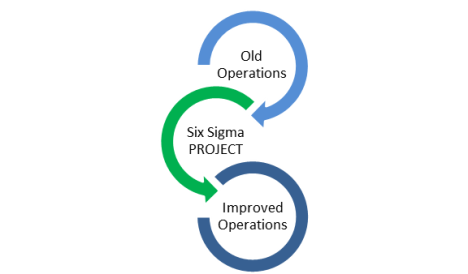In the very first post on Chapter 1, I talked about the conceptual differences between a project and operational work. Here’s a summary of those differences.
| Duration | Creates | |
| Project | Temporary (starts and ends) | Unique product, service, or result, or improvement in existing product or service |
| Operational Work | Ongoing (repetitive) | Repetitive product (mass production) or service |
In reality, an organization will have both going at the same time, and the subject of this post covers the important topic of the relationships between the two of them. Note that the PMBOK® Guide does not include details about operations management because it is considered out of the scope of the book.
1. Intersection of projects and operations work
Let’s say you are an automobile manufacturer who wants to design and build a new car for mass production. The car will need to be designed, and then a prototype will be built which will then be tested in order to see if it can meet various government safety and environmental standards. Although the concept of the life cycle of a project is actually covered in Chapter 2 rather than this chapter, you can intuitively see that the design can be logically split into two different phases, designing the prototype and then testing it. You could into fact take these two phases and split them into what is essentially two different projects. However you divide up the project work, once the car is designed and tested, the results of the project of the car design then are passed over to the operations group, which will then mass produce the automobile on the assembly line. So the sequence could be represented as follows, with design and test being considered two projects or two phases of a single project (colored in blue), and then mass production being operational work (colored in green).
. 
There are other possible ways for a project and operational work to intersect. A project, for example, could take place DURING the course of operational work, as when a Six Sigma Project is carried out which is designed to reduce defects that occur in the course of ongoing operations, so that the old operations work is improved in the process. 
No matter the point at which they intersect, the important thing for an organization to be aware of is that there needs to be a coordinated transfer between the results of a project and the operational work which will take over that result and produce it on a massive scale and over a long period of time, in the case of a new product, or will take over that result and use it to improve ongoing operations, as in the case of a Six Sigma project.
2. Operational Stakeholders in Project Management
Because of the transfer mentioned above at the intersection of projects and operations, project managers need to include those from the operations section of the organization as stakeholders in their projects, because they will have to ultimately live with the results of the project the manager is working on. The complete list of potential stakeholders in operations is given in the PMBOK® Guide, Chapter 1, section 1.5.1.2. The important thing is that you are aware of the reason WHY they are included.
3. Business Plan and Strategic Considerations
Projects and operational work both have in common the fact that they must both respond to external strategic considerations (e.g., responding to market demand) and internal business needs (i.e., “the bottom line”). In this respect, they are both effected by changes in circumstances outside or within the organization.
The conclusion is that an organization needs to make sure that its project work and its ongoing operations work are complementary and work together to achieve the organization’s aims and goals.
The next and final post regarding chapter 1 will be on the role and responsibilities of a project manager.
Filed under: Uncategorized |


Great explanation. Cleared the concepts and doubts very easily.
Thanks